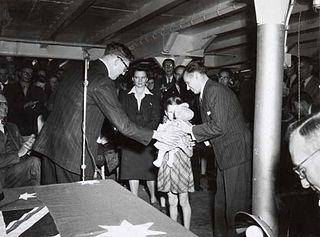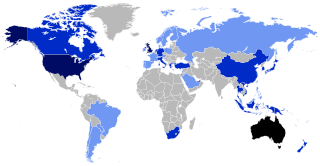| Total population | |
|---|---|
| 1,928 (by birth, 2011 Census ) [1] 8,551 (by ancestry, 2011 Census ) [1] | |
| Regions with significant populations | |
| Estonia-born people by state or territory | |
| New South Wales | 731 [1] |
| Victoria | 365 [1] |
| Queensland | 290 [1] |
| Western Australia | 240 [1] |
| Languages | |
| Australian English · Estonian | |
| Religion | |
| Christianity (Predominantly Lutheranism) | |
| Related ethnic groups | |
| Finnish Australians, Estonian Americans | |
Estonian Australians (Estonian : Austraalia eestlased) refers to Australian citizens of Estonian descent or Estonia-born persons who reside in Australia. According to the 2011 Census, there were 8,551 people of Estonian descent in Australia and 1,928 Estonia-born people residing in the country at the moment of the census, having a fall of 0.4 per cent compared to the 2006 Census. The largest Estonia-born community in Australia is in the state of New South Wales, with 731 people. [1]
From 1940 to 1944, more than 70,000 Estonians fled to the West due to the Soviet and German occupations. Many settled in Australia. [2] The first voyage under Arthur Calwell's Displaced Persons immigration program, that of the USS General Stuart Heintzelman in 1947, [3] was specially chosen to be all from Baltic nations, all single, many blond and blue-eyed, in order to appeal to the Australian public. [4] Of the 843 immigrants on the Heintzelman, 142 were Estonian. [5]

The White Australia policy is a term encapsulating a set of historical policies that aimed to forbid people of non-European ethnic origin, especially Asians and Pacific Islanders, from immigrating to Australia, starting in 1901. Governments progressively dismantled such policies between 1949 and 1973.
Anglo-Celtic Australians is an ancestral grouping of Australians whose ancestors originate wholly or partially in the British Isles - predominantly in England, Ireland, Scotland and Wales.
The Scottish diaspora consists of Scottish people who emigrated from Scotland and their descendants. The diaspora is concentrated in countries such as the United States, Canada, Australia, England, New Zealand, Ireland and to a lesser extent Argentina, Chile and Brazil.

Post-war immigration to Australia deals with migration to Australia in the decades immediately following World War II, and in particular refers to the predominantly European wave of immigration which occurred between 1945 and the end of the White Australia policy in 1973. In the immediate aftermath of World War II, Ben Chifley, Prime Minister of Australia (1945–1949), established the federal Department of Immigration to administer a large-scale immigration program. Chifley commissioned a report on the subject which found that Australia was in urgent need of a larger population for the purposes of defence and development and it recommended a 1% annual increase in population through increased immigration.
Serbian Australians, are citizens of Australia who fully, or partially identify as Serbian by birth or descent. In the 2021 census there were 94,997 people in Australia of Serbian ancestry, making it a significant group with the global Serb diaspora.

Australians, colloquially known as Aussies, are the citizens, nationals and individuals associated with the country of Australia. This connection may be residential, legal, historical or ethno-cultural. For most Australians, several of these connections exist and are collectively the source of their being Australian. Australian law does not provide for a racial or ethnic component of nationality, instead relying on citizenship as a legal status.
Maltese Australians are Australian citizens who are fully or partially of Maltese descent or Malta-born people who reside in Australia. While most of them emigrated to Australia from Malta, a number emigrated from the United Kingdom where they had settled after having been expelled from Egypt, as holders of British passports, during the Suez Crisis. According to the 2021 Census, there were 198,989 people of Maltese descent in Australia and 35,413 Malta-born people residing in the country at the moment of the census.
Swedish Australians are Australians with Swedish ancestry, most often related to the large groups of immigrants from Sweden in the late nineteenth century and early twentieth century. The 2011 Census showed 34,029 people who claimed Swedish ancestry, having an increase compared to those 30,375 in 2006. Most Swedish Australians are Lutherans affiliated with the Evangelical Lutheran Church. They form the largest Scandinavian minority in Australia.
Slovene Australians are Australian citizens who are fully or partially of Slovene descent or Slovenia-born people who reside in Australia.

English Australians, also known as Anglo-Australians, are Australians whose ancestry originates wholly or partly in England. In the 2021 census, 8,385,928 people, or 33% of the Australian population, stated that they had English ancestry. It is the largest self-identified ancestry in Australia. People of ethnic English origin have been the largest group to migrate to Australia since the establishment of the Colony of New South Wales in 1788.
Hispanic and Latin American Australians refers to Australian persons who are of Hispanic, and/or Latin American origin irrespective of their ancestral backgrounds, and their descendants. Brazilian Australians make up the largest proportion of Hispanic and/or Latin American Australians, followed by Chilean Australians and Salvadoran Australians. Most Hispanic and Latin American Australians speak English but many continue to use Spanish or Portuguese as well.

Spanish Australians refers to Australian citizens and residents of Spanish descent, or people who were born in Spain and immigrated to Australia. There are approximately 123,000 Australians who are of full or partial Spanish descent, most of whom reside within the major cities of Sydney and Melbourne, with lesser but rapidly growing numbers in Brisbane and Perth. Of these, according to the 2011 Australian census, 13,057 were born in Spain.
Argentine Australians are Australian citizens of Argentine descent or birth. According to the Census there were 9,879 Australians who claimed full or partial Argentine ancestry and 20,940 Argentina-born citizens who were residing in Australia at the moment of the census.
Salvadoran Australians are Australians of Salvadoran descent. Salvadoran immigration to Australia was caused principally by economic and political turmoil in El Salvador.

New Zealand Australians refers to Australian citizens whose origins are in New Zealand, as well as New Zealand migrants and expatriates based in Australia. Migration from New Zealand to Australia is a common phenomenon, given Australia's proximity to New Zealand, its larger economy and cultural links between the two countries.

Belarusian Australians refers to Australians of full or partial Belarusian national background or descent, or Belarusian citizens living in Australia.
Latvian Australians are Australian citizens of Latvian descent, or persons born in Latvia who reside in Australia. At the 2016 Census, 20,509 residents in Australia reported to have Latvian ancestry.
Lithuanian Australians refers to Australian residents of Lithuanian national background or descent. According to the 2016 Census, there were 16,290 people of Lithuanian descent in Australia and 2,609 Lithuania-born people residing in the country at the moment of the census. The largest Lithuanian Australian community is in the state of New South Wales, with 1022 Lithuania-born people, especially located in Sydney.

Foreign relations exist between Australia and Latvia. Australia first recognised Latvia on 22 September 1921 and was among the first countries to re-recognise Latvia's independence on 27 August 1991. Both countries re-established diplomatic relations on 21 November 1991. Australia is represented in Latvia through its embassy in Stockholm, Sweden and an honorary consulate in Riga. Latvia has had an embassy in Canberra since October 2021, and also has honorary consulates in Sydney, Brisbane, Adelaide, Melbourne and Perth.

Foreign relations exist between Australia and Lithuania. Australia was among the first countries to re-recognise Lithuania's independence on 27 August 1991. Both countries formally established diplomatic relations on 6 November 1991. Australia is represented in Lithuania through its embassy in Warsaw, Poland and an honorary consulate in Vilnius. Lithuania has had an embassy in Canberra since 2021, and also has honorary consulates in Sydney, Adelaide, Melbourne and Darwin.